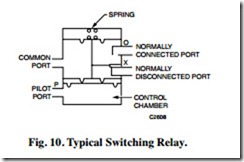THROTTLING RANGE ADJUSTMENT
A controller must always have some means to adjust the throttling range (proportional band). In a pneumatic controller, the throttling range is the change at the sensor required to change the branchline pressure 10 psi. The setpoint is usually at the center of the throttling range. For example, if the throttling range of a temperature controller is 4F and the setpoint is 72F, the branchline pressure is 3 psi at 70F, 8 psi at 72F, and 13 psi at 74F for a direct acting controller.
In all pneumatic systems except the sensor-controller system, the throttling range is adjusted by changing the effective length of a lever arm. In Figure 7, the throttling range is changed by moving the contact point between the bimetal and the flapper. (For information on adjusting the throttling range in a sensor- controller system, see SENSOR-CONTROLLER SYSTEMS.)
RELAYS AND SWITCHES
Relays are used in control circuits between controllers and controlled devices to perform a function beyond the capacity of the controllers. Relays typically have diaphragm logic construction (Fig. 10) and are used to amplify, reverse, average, select, and switch controller outputs before being sent to valve and damper actuators.
